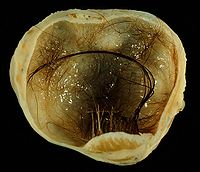
Photo from wikipedia
Malignant gastrointestinal (GI) neuroectodermal tumor is an extremely rare entity that was first described by Zambrano et al. in 2003 as “clear cell sarcoma (CCS)-like tumor of the GI tract.”… Click to show full abstract
Malignant gastrointestinal (GI) neuroectodermal tumor is an extremely rare entity that was first described by Zambrano et al. in 2003 as “clear cell sarcoma (CCS)-like tumor of the GI tract.” It shares some of the histopathological features of CCS but lacks the immunohistochemical (IHC) reactivity for melanocytic markers. Most mesenchymal neoplasms of the GI tract belong to the category of GI stromal tumors and are characterized by the IHC expression of c-KIT. In cases, without detectable KIT receptor expression, several differential diagnoses have to be taken into consideration. In this article, we describe such a case and present a review of all the reported cases till date. We also present the current available knowledge on its pathology and molecular genetics along with the limitations in its diagnosis. Here, we report a case of a 32-year-old man with a tumor of the small bowel composed of polygonal tumor cells arranged in solid nests, alveolar pattern, and pseudopapillary and admixed with numerous osteoclast-like multinucleated giant cells. Immunohistochemically, the tumor cells strongly expressed S-100 protein only. HMB-45, melan-A, CD117, cytokeratin, desmin, smooth muscle actin, and CD-34 were absent. Ki-67 index was 15%. The diagnosis was further confirmed by fluorescence in situ hybridization (FISH) demonstrating the presence of EWSR1 (22q12) translocation. A final diagnosis of malignant gastroneuroectodermal tumor was rendered. The patient is disease-free for 20 months of postsurgery. The diagnosis of this entity should be considered in the presence of S-100-positivity and multinucleated osteoclastic giant cells and the absence of melanocytic differentiation in a tumor arising from GI tract. Further confirmation can be done by performing FISH analysis.
Journal Title: Journal of Cancer Research and Therapeutics
Year Published: 2022
Link to full text (if available)
Share on Social Media: Sign Up to like & get
recommendations!